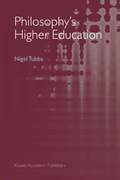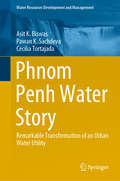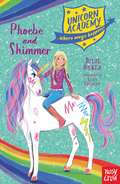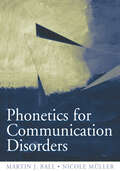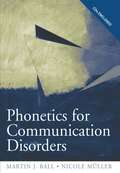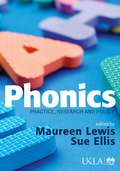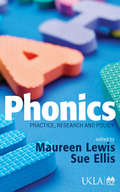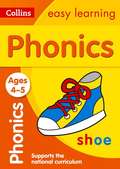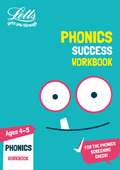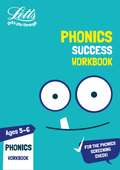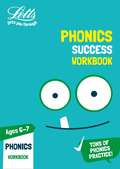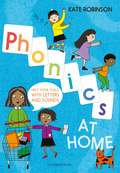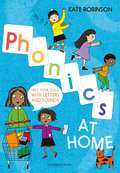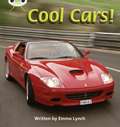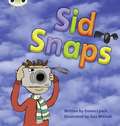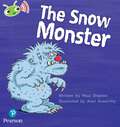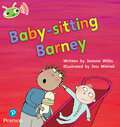- Table View
- List View
Philosophy with Teenagers: Nurturing a Moral Imagination for the 21st Century
by Patricia Hannam Eugenio EcheverriaThis book presents a clear introduction to the theory and practice of the Community of Philosophical Enquiry (P4C) and explains how P4C can facilitate young people's exploration of the key ethical questions of our time, such as intercultural understanding and education for sustainable development. It offers educationalists an opportunity to reflect on how philosophical thinking in young adults can support their development into confident individuals who are successful learners and responsible citizens, and discusses the relevance of this process to educational needs of the 21st Century. Additionally, the book gives practical examples for all practitioners wanting to develop philosophical thinking in their context, and to particularly help teachers implement the new curriculum demands in inspirational ways. The book will be of interest not only to a wide range of secondary teachers but also teacher educators at university level and also policy makers. It could be important for those working in the voluntary sector, for example, with concern for development and environment education. It will be of interest to parents and those in professions closely aligned to teaching such as social or youth work.
Philosophy with Teenagers: Nurturing a Moral Imagination for the 21st Century
by Patricia Hannam Eugenio EcheverriaThis book presents a clear introduction to the theory and practice of the Community of Philosophical Enquiry (P4C) and explains how P4C can facilitate young people's exploration of the key ethical questions of our time, such as intercultural understanding and education for sustainable development. It offers educationalists an opportunity to reflect on how philosophical thinking in young adults can support their development into confident individuals who are successful learners and responsible citizens, and discusses the relevance of this process to educational needs of the 21st Century. Additionally, the book gives practical examples for all practitioners wanting to develop philosophical thinking in their context, and to particularly help teachers implement the new curriculum demands in inspirational ways. The book will be of interest not only to a wide range of secondary teachers but also teacher educators at university level and also policy makers. It could be important for those working in the voluntary sector, for example, with concern for development and environment education. It will be of interest to parents and those in professions closely aligned to teaching such as social or youth work.
Philosophy's Higher Education
by Nigel TubbsAt about the age of 13 I began to realise that my formal education was separating itself off from my philosophical education. Of course, at the time I did not know it in this way. I experienced it as a split between what I was being taught and my experience of what I was being taught. It was, I now know, the philosophical experience of formal schooling. It was not until beginning the study of sociology at 16 that I came across the idea of dualisms—pairs of opposites that always appeared together but were never reconciled. In sociology it was the dualism of the individual and society. The question most asked in our classes was always regarding which aspect of the dualism dominated the other. The answer we always leaned towards was that both were mutually affected by the other. The answer seemed to lie somewhere in the middle. It was only at university, first as an undergraduate and then as a postgraduate, that I came across the idea of the dialectic. Slowly I began to recognise that the dualisms which plagued social theory—I and we, self and other, good and evil, modernity and post-modernity, autonomy and heteronomy, freedom and nature, truth and relativism, and so many more—were not only dialectical in being thought about, but also that the thought of them being dialectical had an even stranger quality. It was the same experience as being at school.
Phinehas, the Sons of Zadok, and Melchizedek: Priestly Covenant in Late Second Temple Texts (The Library of Second Temple Studies #90)
by Dongshin Don ChangDongshin Don Chang examines 1 and 2 Maccabees, the Dead Sea Scrolls, and Hebrews to see how the combined concepts of covenant and priesthood are defined and interlinked within various biblical and extra-biblical traditions. The three studies show the interesting and varying dynamics of the use of combined concepts of covenant and priesthood. The articulations of the two entities are shown to reflect, in part, the concern of the Second Temple Jewish authors; how significant the priestly institutions and priesthood were, not only in cultic matters, but also in relation to political and authoritative concerns.Chang's analysis makes clear that some of the Second Temple compositions have pursued ideas of the legitimacy of priestly identities by juxtaposing the concepts of covenant and priesthood from various traditions. Interpretation and representation of certain traditions becomes a way in which some Second Temple Jews, and some members of the early Jewish Christian communities, developed their priestly covenantal identities. It is with an understanding of this, Chang argues, that we can better understand these Second Temple texts.
Phnom Penh Water Story: Remarkable Transformation of an Urban Water Utility (Water Resources Development and Management)
by Asit K. Biswas Pawan K. Sachdeva Cecilia TortajadaThis book analyses how a water utility from a developing country, Phnom Penh Water Supply Authority, that was totally dysfunctional, corruption-ridden and literally bankrupt in 1993, became one of the most successful water utilities of the developing world in only about 15 years. By 2010, some of the performance indicators of this public sector utility were even better than London, Paris or Los Angeles. The book further analyses the enabling conditions that made this remarkable transformation possible. Based on this analysis, a framework is recommended for water utilities from developing countries so that they can also be transformed into functional, efficient, equitable and financially viable institutions on a sustainable basis.
Phoebe and Shimmer (Unicorn Academy #13)
by Julie SykesWhen your best friend is a unicorn, magical adventures are guaranteed! Imagine a school where you meet your own unicorn and have amazing adventures together! That's what happens for the girls at Unicorn Academy on beautiful Unicorn Island.Phoebe and Shimmer are having a brilliant time at Unicorn Academy. They're always on the lookout for excitement and adventure! On a school trip to the coast, a freak weather event puts everyone in danger. Shimmer's magic might be able to save them - but they'll have to think fast and be very brave!With a glittery cover and beautifully illustrated throughout by Lucy Truman, Unicorn Academy is the perfect series for 7+ readers who love magic and adventure.Have you read the other Unicorn Academy stories?Sophia and RainbowScarlett and BlazeAva and StarIsabel and CloudLayla and DancerOlivia and SnowflakeRosa and CrystalAriana and WhisperMatilda and PearlFreya and HoneyViolet and TwinkleIsla and ButtercupLily and Feather
Phoneme Track Workbook
by Laura CryerThis photocopiable workbook links with the Phoneme Track CD-ROM, published by SEMERC to support phonics work within the National Literacy Strategy, focusing on hearing, identifying, segmenting and blending of phonemes. Without specific phoneme awareness training, phonics can make no sense and spellings of words can only be learned by rote - reading is there fore not able to be automatic. Research indicates that all young readers benefit from explicit assistance with phonemic awareness and many need more intensive training. The book is suitable for Key Stage 1 and 2 pupils and older learners with specific phonological difficulties.
Phoneme Track Workbook
by Laura CryerThis photocopiable workbook links with the Phoneme Track CD-ROM, published by SEMERC to support phonics work within the National Literacy Strategy, focusing on hearing, identifying, segmenting and blending of phonemes. Without specific phoneme awareness training, phonics can make no sense and spellings of words can only be learned by rote - reading is there fore not able to be automatic. Research indicates that all young readers benefit from explicit assistance with phonemic awareness and many need more intensive training. The book is suitable for Key Stage 1 and 2 pupils and older learners with specific phonological difficulties.
Phonetic Symbol Guide
by Geoffrey K. Pullum William A. LadusawPhonetic Symbol Guide is a comprehensive and authoritative encyclopedia of phonetic alphabet symbols, providing a complete survey of the hundreds of characters used by linguists and speech scientists to record the sounds of the world's languages. This fully revised second edition incorporates the major revisions to the International Phonetic Alphabet made in 1989 and 1993. Also covered are the American tradition of transcription stemming from the anthropological school of Franz Boas; the Bloch/Smith/Trager style of transcription; the symbols used by dialectologists of the English language; usages of specialists such as Slavicists, Indologists, Sinologists, and Africanists; and the transcription proposals found in all major textbooks of phonetics. With sixty-one new entries, an expanded glossary of phonetic terms, added symbol charts, and a full index, this book will be an indispensable reference guide for students and professionals in linguistics, phonetics, anthropology, philology, modern language study, and speech science.
Phonetic Symbol Guide
by Geoffrey K. Pullum William A. LadusawPhonetic Symbol Guide is a comprehensive and authoritative encyclopedia of phonetic alphabet symbols, providing a complete survey of the hundreds of characters used by linguists and speech scientists to record the sounds of the world's languages. This fully revised second edition incorporates the major revisions to the International Phonetic Alphabet made in 1989 and 1993. Also covered are the American tradition of transcription stemming from the anthropological school of Franz Boas; the Bloch/Smith/Trager style of transcription; the symbols used by dialectologists of the English language; usages of specialists such as Slavicists, Indologists, Sinologists, and Africanists; and the transcription proposals found in all major textbooks of phonetics. With sixty-one new entries, an expanded glossary of phonetic terms, added symbol charts, and a full index, this book will be an indispensable reference guide for students and professionals in linguistics, phonetics, anthropology, philology, modern language study, and speech science.
Phonetics: A Coursebook (PDF)
by Rachael-Anne KnightA problem-based introduction to phonetics, with over three hundred exercises integrated into the text to help the student discover and practice the subject interactively. It assumes no previous knowledge of the subject and highlights and explains new terms and concepts when they are first introduced. Graded review questions and exercises at the end of every unit help the student monitor their own progress and further practice new skills, and there is frequent cross-referencing for the student to see how the subject fits together and how later concepts build on earlier ones. The book highlights the differences between speech and writing in Unit One and covers all the essential topics of a phonetics course.
Phonetics for Communication Disorders
by Martin J. Ball Nicole MullerThis comprehensive textbook offers a basic introduction to phonetics in an applied systematic presentation that equips the communication disorders student to deal with the wide range of speech types that will be encountered in a clinic. While the major discussion is articulatory, speech acoustics are also examined. Illustrations of sample spectrograms appear in tandem with the more traditional articulatory drawings. Two CDs of sound examples accompany the textbook. This comprehensive textbook offers a basic introduction to phonetics in an applied systematic presentation that equips the communication disorders student to deal with the wide range of speech types that will be encountered in a clinic. While the major discussion is articulatory, speech acoustics
Phonetics for Communication Disorders
by Martin J. Ball Nicole MullerThis comprehensive textbook offers a basic introduction to phonetics in an applied systematic presentation that equips the communication disorders student to deal with the wide range of speech types that will be encountered in a clinic. While the major discussion is articulatory, speech acoustics are also examined. Illustrations of sample spectrograms appear in tandem with the more traditional articulatory drawings. Two CDs of sound examples accompany the textbook. This comprehensive textbook offers a basic introduction to phonetics in an applied systematic presentation that equips the communication disorders student to deal with the wide range of speech types that will be encountered in a clinic. While the major discussion is articulatory, speech acoustics
Phonics: Practice, Research and Policy (PDF)
by Susan J Ellis Maureen LewisPhonics: Practice, Research and Policy unravels the controversy surrounding phonics which currently characterises much of the discussion about reading standards and teaching reading. Bringing some much-needed balance to the debate - the book offers genuinely focused advice on how to make sense of the various theories and on their applications in practice, helping teachers to find the right practical solutions to suit the children in their settings. The book includes chapters on: - How children learn to read and how phonics helps - The role of early phonics teaching - Classroom approaches to phonics teaching - Involving parents and carers - Speaking and phonological awareness - Spelling links - Staff development - Responses to the Rose Review on Early Reading. It will be essential reading for student teachers on initial training courses, and for more experienced staff in a range of school settings.
Phonics: Practice, Research and Policy
by Maureen Lewis Susan J EllisPhonics: Practice, Research and Policy unravels the controversy surrounding phonics which currently characterises much of the discussion about reading standards and teaching reading. Bringing some much-needed balance to the debate - the book offers genuinely focused advice on how to make sense of the various theories and on their applications in practice, helping teachers to find the right practical solutions to suit the children in their settings. The book includes chapters on: - How children learn to read and how phonics helps - The role of early phonics teaching - Classroom approaches to phonics teaching - Involving parents and carers - Speaking and phonological awareness - Spelling links - Staff development - Responses to the Rose Review on Early Reading. It will be essential reading for student teachers on initial training courses, and for more experienced staff in a range of school settings.
Phonics, Ages 4-5 (Collins Easy Learning Preschool Ser.)
by Collins UK Publishing StaffAn engaging Phonics activity book to really help boost your child's progress at every stage of their learning! Fully in line with the Early Years Foundation Stage, this English book provides reassurance whilst supporting your child's learning at home. Combining useful English practice with engaging, colourful illustrations, this Phonics practice book helps to boost your child's confidence and develop good learning habits for life. Each fun activity is designed to give your child a real sense of achievement.
Phonics Ages 4-5 Practice Workbook (Letts KS1 Practice Ser.)
by Letts StaffLevel: KS1 Subject: Phonics Help develop your child’s reading and writing skills at home using this invaluable practice workbook. In line with the new National Curriculum, this Phonics practice workbook provides invaluable skills practice and preparation for KS1 National Tests (SATs). Matched to the requirements of the National Curriculum, this KS1 Phonics practice workbook contains plenty of useful questions and answers to test children’s understanding, and engaging images and diagrams to make learning more enjoyable.
Phonics Ages 5-6 Practice Workbook (Letts KS1 Revision Success Ser.)
by Letts StaffLevel: KS1 Subject: Phonics Help develop your child’s reading and writing skills at home using this invaluable practice workbook. In line with the new National Curriculum, this Phonics practice workbook provides invaluable skills practice and preparation for KS1 National Tests (SATs). Matched to the requirements of the National Curriculum, this KS1 Phonics practice workbook contains plenty of useful questions and answers to test children’s understanding, and engaging images and diagrams to make learning more enjoyable.
Phonics Ages 6-7 Practice Workbook (Letts KS1 Revision Success Ser.)
by Letts StaffLevel: KS1 Subject: Phonics Help develop your child’s reading and writing skills at home using this invaluable practice workbook. In line with the new National Curriculum, this Phonics practice workbook provides invaluable skills practice and preparation for KS1 National Tests (SATs). Matched to the requirements of the National Curriculum, this KS1 Phonics practice workbook contains plenty of useful questions and answers to test children’s understanding, and engaging images and diagrams to make learning more enjoyable.
Phonics at Home: Help your child with letters and sounds
by Kate RobinsonPhonics at Home contains over 40 fun, multi-sensory games and activities to bring phonics strategies to life outside of the classroom. Perfect for parents keen to understand phonics and support their child with letters and sounds, this practical guide complements phonic schemes that are already used in primary schools.Kate Robinson uses her wealth of experience as a teacher and teacher trainer to demystify phonics with clear explanations of related terminology and step-by-step instructions to help parents and children make the most of every activity. What's more, the easy-to-play games work with any phonics scheme – it doesn't matter which scheme the school is using – and use items found around the house.Ideal for Key Stage 1 and early Key Stage 2 children, this practical book is a necessity for all parents keen to support their child's reading and spelling development at home.
Phonics at Home: Help your child with letters and sounds
by Kate RobinsonPhonics at Home contains over 40 fun, multi-sensory games and activities to bring phonics strategies to life outside of the classroom. Perfect for parents keen to understand phonics and support their child with letters and sounds, this practical guide complements phonic schemes that are already used in primary schools.Kate Robinson uses her wealth of experience as a teacher and teacher trainer to demystify phonics with clear explanations of related terminology and step-by-step instructions to help parents and children make the most of every activity. What's more, the easy-to-play games work with any phonics scheme – it doesn't matter which scheme the school is using – and use items found around the house.Ideal for Key Stage 1 and early Key Stage 2 children, this practical book is a necessity for all parents keen to support their child's reading and spelling development at home.
Phonics Bug, Non-Fiction Phase 4: Cool Cars (PDF)
by Emma LynchThis title is part of Phonics Bug - the first Phonics programme to bring together research-based teaching methods with 100% decodable books. In this book for Phonics Phase 4 read all about some of the coolest and quickest cars in the world. This book includes the following words: out, some, have, no, there, like, were, what.
Phonics Bug, Phase 4: Sid Snaps (PDF)
by Emma LynchThis title is part of Phonics Bug - the first Phonics programme to bring together research-based teaching methods with 100% decodable books, CBeebies video, and an online reading world to give today s children a firm, fun foundation in Phonics. In this book for Phonics Phase 4: Sid just can't stop snapping. His pictures are very bad - or are they? This book includes the following words: said, so, do, come, were, there, little, one, when. This title was originally published as part of Rigby Star Phonics .
Phonics Bug, Phase 5: The Snow Monster (PDF) (Bug Club Phonics)
by Paul ShiptonThis title is part of Phonics Bug - the first Phonics programme to bring together research-based teaching methods with 100 per cent decodable books, CBeebies video, and an online reading world to give today s children a firm, fun foundation in Phonics.
Phonics Bug, Phase 5: Babysitting Barney (PDF) (Phonics Bug Ser.)
by Jeanne WillisThis title is part of Phonics Bug - the first Phonics programme to bring together research-based teaching methods with 100 per cent decodable books, CBeebies video, and an online reading world to give today's children a firm, fun foundation in Phonics.Baby Barney will not go to sleep. Can Sid stop him screaming? This book includes the following words: looked, called, asked.

